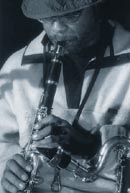
|
|
|
|
|
|
Photo Credit: Jeffrey Kliman |
Don Byron
For many aspiring jazz musicians, the B-flat clarinet is a gateway instrument that usually leads to the saxophone. Though Don Byron did learn to play the sax, he stuck with the clarinet and made it his main instrument. On this edition of Billy Taylor's Jazz at the Kennedy Center, Byron talks about his decision and how it let him explore every music style from Western classical to klezmer. Known for his eclecticism, Byron reminds the Kennedy Center audience that straight-ahead jazz is never far from his heart -- or his horn. After the ensemble swings through Juan Tizol's classic "Perdido," Dr. Taylor asks his guest about his musical upbringing. Byron explains that he grew up in a Bronx household where "Cannonball was king." Unable to play alto sax as well as Cannonball Adderley, he explored the baritone and longed to play with Latin jazz bandleaders Mario Bauza and Eddie Palmieri. In contrast, his clarinet studies focused mainly on classical works by composers like Gustav Mahler and Igor Stravinsky. Byron first heard the possibilities for jazz clarinet after discovering the music of Tony Scott and Jimmy Hamilton. Both players, he says, had a rich tone and made the instrument relevant for contemporary jazz. He was hooked. Given his wide-ranging interests, Byron has little patience for critics who frown on music that isn't "pure jazz." "If you're on the inside of things," he tells Dr. Taylor, "then you know nothing is pure anything." Above all else, Byron cherishes versatility: he feels equally at home playing the music of Raymond Scott and George Russell. He tells Dr. Taylor that his saxophone heroes all crossed genre lines. Gary Bartz, for example, borrowed from rock and funk as well as John Coltrane. Joe Henderson could fit in with a blues organ trio or a hard bop quintet. Byron demonstrates similar flexibility when performing Henderson's bossa-tinged "Recordame" and John Lewis's meditative "Django" with Dr. Taylor's trio. As a junior high school student, Byron took up the bass clarinet. "People thought the brothers could play the bass clarinet better, 'cause it was bigger and our lips were bigger!" he jokes. Byron tells Dr. Taylor that Eric Dolphy was a major inspiration. A talented alto saxophonist and flutist, Dolphy brought a unique emotional intensity to the bass clarinet. "You hear one note and it's like a whole world of stuff -- an ethnic group that has only one person in it," says Byron. That distinctiveness drew him deeper into the world of jazz as he sought his own musical voice. Dolphy's influence can be heard as Byron takes up the bass clarinet for "The Shadow of Your Smile." Taking questions from the audience, Byron says that other influences include the musical scores from cartoons. He speaks highly of the Warner Brothers' Orchestra: "It's a lot of people's first exposure to classical music and probably mine." He also has great respect for composers Julius Hemphill and Henry Threadgill, but laments that they have not reached a wider audience. "If they weren't brothers, they would be Phillip Glass and those kind of guys," he says.
All these influences have made Don Byron one of the most inventive players on the scene today. Always eager to try out new ideas, he can bring a distinctive and irreverent voice to the klezmer of Mickey Katz as well as the film themes of Henry Mancini. But when Dr. Taylor suggests closing the concert with the bebop classic "Donna Lee," Byron happily jumps into it and shows that his jazz chops are as strong as ever.
|
|
| |
